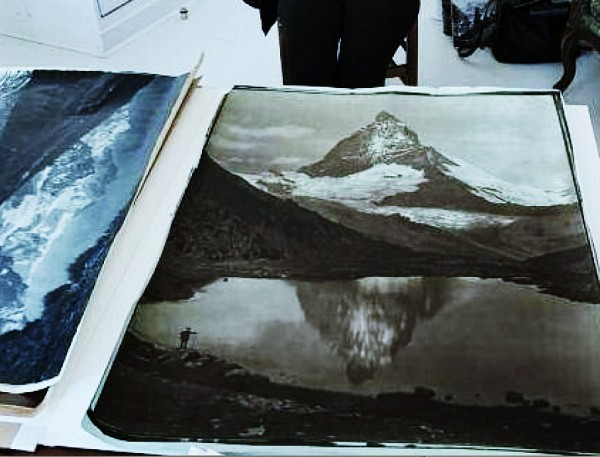Important Adolphe Braun Auction Set for Paris on May 17th
Skinner Schedules Spring Prints and Photographs Auction for May 19th
Photography Book Reviews: Thiollier's 19th Century, Dawoud Bey's Community
Over 250 New Items Posted up for Sale on I Photo Central Web Site in Just the Last Few Months
New Special Exhibits Go up on I Photo Central

What is perhaps the most important auction of Braun and Company photographs will take place at the Hotel Drouot, Paris, at 3 pm on Wednesday, May 17th. Presented by Binoche et Giquello, the auction will feature many rarities among the 55 lots being offered in the sale. Included in the sale will be some multi-print panoramas (up to 95 inches wide), carbon prints, and mammoth plate and larger prints (many as large as 32 x 26 inches)—nearly all of the alpine mountains and glaciers that the Brauns were most noted for.
Adolphe Braun (1812-1877) was a European photographer, best known for his floral still lifes, Parisian street scenes, and grand Alpine landscapes. One of the most influential photographers of the 19th century, he used contemporary innovations in photographic reproduction to market his photographs worldwide. In his later years, he used photographic techniques to reproduce famous works of art, which helped advance the field of art history.
Nothing is more difficult to photograph than the mountains, with their problem of accessibility, light, composition, etc.
In 1864, Adolphe Braun became a member of the Société Française de Photographie. At this time his former commercial relations with Parisian photographers Gaudin brothers had soured dramatically. The reasons why are still a puzzling question for photo historians.
By the 1860s, the Braun et Cie studio was operating in a factory-like manner, producing its own energy and all of its own materials except paper. A very unusual enterprise, conceived in an autarchic way. The studio created thousands of stereoscopic images of the Alpine regions of France, Germany, Switzerland and Italy, as well as most of the rest of Europe. Braun also produced a number of large-format panoramic images of the Alpine countryside, using the pantoscopic camera developed by English inventors John Johnson and John Harrison.

Lot 55, Chamonix, Mer de Glace et Aiguille du Dru, vers 1889, 810 x 650 mm, Carbon Print.
In the mid-1860s, Braun invested in a new carbon printing method developed by English chemist Joseph Wilson Swan. After 1866, Braun used the new carbon method to create a series of large-format alpine scenes, as well as hunting scenes entitled, "Panoplies de Gibier". He also used the new carbon print method to produce photographs of well-known works of art from places such as the Louvre, the Vatican and the Albertina, as well as of various sculptures in France, the Netherlands and Italy. This endeavor eventually proved successful, and the Braun studio focused primarily on art reproductions.
The preview will be held at Drouot in Salle 1 on Tuesday, May 16, from 11 am to 6 pm; and on Wednesday, May 17, from 11 am to noon. The auction will be held in the same room at 3 pm on Wednesday, May 17. Private viewing of the lots can be arranged through the expert.
Besides in the auction room itself and left-commission bids, auction bidding will be available online at: http://www.drouotlive.com. Phone bidders can also be accommodated. Serge Plantureux is the multi-lingual auction expert on the sale, and can be reached at 011 (or 00 from outside the USA) 140-16-80-80; mobile +33-6-50-85-60-74, or by email at: serge@plantureux.fr. PDF catalogues can be sent on request to the expert; and the catalogue can be found here online at: http://catalogue.drouot.com/html/d/index.jsp?id=83260. The contact at Binoche and Giquello for this auction is Raphaële Laxan, who can be reached at
+33-1-47-70-48-00 and by email at: r.laxan@betg.fr.
Important Adolphe Braun Auction Set for Paris on May 17th
Skinner Schedules Spring Prints and Photographs Auction for May 19th
Photography Book Reviews: Thiollier's 19th Century, Dawoud Bey's Community
Over 250 New Items Posted up for Sale on I Photo Central Web Site in Just the Last Few Months
New Special Exhibits Go up on I Photo Central


Share This